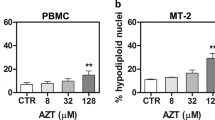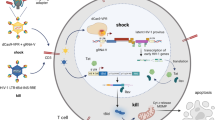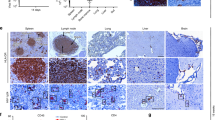Abstract
Human T-cell leukemia virus type 1 (HTLV-1), which causes adult T-cell leukemia (ATL) in humans, establishes a life-long latent infection. Current therapies are not very effective against HTLV-1-associated disorders. A novel therapeutic approach may help to combat HTLV-1 infection. A molecular therapy that targets the proviral genome is favorable because the therapeutic effect occurs specifically in HTLV-1-infected cells, regardless of whether they express viral genes. In this proof-of-concept study, we developed a therapeutic molecule based on zinc finger nuclease (ZFN) to achieve this goal. We designed a ZFN that specifically recognized conserved region of HTLV-1 long terminal repeat (LTR) and introduced it into various HTLV-1-positive human T-cell lines, including HTLV-1-transformed and ATL-derived cell lines. The ZFN disrupted the promoter function of HTLV-1 LTR and specifically killed HTLV-1-infected cells. We also showed a potential approach of this therapeutic molecule to remove the proviral genome from HTLV-1-infected cells, something that has not been possible before. The therapeutic effect of ZFN was confirmed in an in vivo model of ATL. This strategy may form the basis of a therapy that can eradicate HTLV-1 infection. Similar approaches can be used to target other malignancy-associated viruses.
This is a preview of subscription content, access via your institution
Access options
Subscribe to this journal
Receive 12 print issues and online access
$259.00 per year
only $21.58 per issue
Buy this article
- Purchase on Springer Link
- Instant access to full article PDF
Prices may be subject to local taxes which are calculated during checkout




Similar content being viewed by others
Accession codes
References
Nagai M, Osame M . Human T-cell lymphotropic virus type I and neurological diseases. J Neurovirol 2003; 9: 228–235.
Watanabe T . HTLV-1-associated diseases. Int J Hematol 1997; 66: 257–278.
Yasunaga J, Matsuoka M . Molecular mechanisms of HTLV-1 infection and pathogenesis. Int J Hematol 2011; 94: 435–442.
Faris M . Potential for molecular targeted therapy for adult T-cell leukemia/lymphoma. Int Rev Immunol 2008; 27: 71–78.
Taylor GP, Matsuoka M . Natural history of adult T-cell leukemia/lymphoma and approaches to therapy. Oncogene 2005; 24: 6047–6057.
Carroll D . Progress and prospects: zinc-finger nucleases as gene therapy agents. Gene Ther 2008; 15: 1463–1468.
Cannon P, June C . Chemokine receptor 5 knockout strategies. Curr Opin HIV AIDS 2011; 6: 74–79.
Handel EM, Cathomen T . Zinc-finger nuclease based genome surgery: it's all about specificity. Curr Gene Ther 2011; 11: 28–37.
Onishi M, Kinoshita S, Morikawa Y, Shibuya A, Phillips J, Lanier LL et al. Applications of retrovirus-mediated expression cloning. Exp Hematol 1996; 24: 324–329.
Kawakami Y, Miura T, Bissonnette R, Hata D, Khan WN, Kitamura T et al. Bruton's tyrosine kinase regulates apoptosis and JNK/SAPK kinase activity. Proc Natl Acad Sci USA 1997; 94: 3938–3942.
Komano J, Miyauchi K, Matsuda Z, Yamamoto N . Inhibiting the Arp2/3 complex limits infection of both intracellular mature vaccinia virus and primate lentiviruses. Mol Biol Cell 2004; 15: 5197–5207.
Shimizu S, Urano E, Futahashi Y, Miyauchi K, Isogai M, Matsuda Z et al. Inhibiting lentiviral replication by HEXIM1, a cellular negative regulator of the CDK9/cyclin T complex. AIDS 2007; 21: 575–582.
Ono A, Hattori S, Kariya R, Iwanaga S, Taura M, Harada H et al. Comparative study of human hematopoietic cell engraftment into BALB/c and C57BL/6 strain of rag-2/jak3 double-deficient mice. J Biomed Biotechnol 2011; 2011: 539748.
Attia MA, Weiss DW . Immunology of spontaneous mammary carcinomas in mice. V. Acquired tumor resistance and enhancement in strain A mice infected with mammary tumor virus. Cancer Res 1966; 26: 1787–1800.
Harada H, Suzu S, Ito T, Okada S . Selective expansion and engraftment of human CD16+ NK cells in NOD/SCID mice. Eur J Immunol 2005; 35: 3599–3609.
Salahuddin SZ, Markham PD, Wong-Staal F, Franchini G, Kalyanaraman VS, Gallo RC . Restricted expression of human T-cell leukemia--lymphoma virus (HTLV) in transformed human umbilical cord blood lymphocytes. Virology 1983; 129: 51–64.
Hsu DK, Hammes SR, Kuwabara I, Greene WC, Liu FT . Human T lymphotropic virus-I infection of human T lymphocytes induces expression of the beta-galactoside-binding lectin, galectin-3. Am J Pathol 1996; 148: 1661–1670.
Okada M, Maeda M, Tagaya Y, Taniguchi Y, Teshigawara K, Yoshiki T et al. TCGF(IL 2)-receptor inducing factor(s). II. Possible role of ATL-derived factor (ADF) on constitutive IL 2 receptor expression of HTLV-I(+) T cell lines. J Immunol 1985; 135: 3995–4003.
Perez EE, Wang J, Miller JC, Jouvenot Y, Kim KA, Liu O et al. Establishment of HIV-1 resistance in CD4+ T cells by genome editing using zinc-finger nucleases. Nat Biotechnol 2008; 26: 808–816.
Holt N, Wang J, Kim K, Friedman G, Wang X, Taupin V et al. Human hematopoietic stem/progenitor cells modified by zinc-finger nucleases targeted to CCR5 control HIV-1 in vivo. Nat Biotechnol 2010; 28: 839–847.
Willmore E, de Caux S, Sunter NJ, Tilby MJ, Jackson GH, Austin CA et al. A novel DNA-dependent protein kinase inhibitor, NU7026, potentiates the cytotoxicity of topoisomerase II poisons used in the treatment of leukemia. Blood 2004; 103: 4659–4665.
Acknowledgements
This work was supported by the Japan Health Science Foundation, the Japanese Ministry of Health, Labor and Welfare (H23-Shinko-Ippan-028).
Author contributions
AT, ST, EU, RK, KM, SO and JK planned and performed the experiments, and analyzed the data. AT, ST, SO and JK wrote the manuscript.
Author information
Authors and Affiliations
Corresponding author
Ethics declarations
Competing interests
The authors declare no conflict of interest.
Additional information
Supplementary Information accompanies this paper on the Leukemia website
Supplementary information
Rights and permissions
About this article
Cite this article
Tanaka, A., Takeda, S., Kariya, R. et al. A novel therapeutic molecule against HTLV-1 infection targeting provirus. Leukemia 27, 1621–1627 (2013). https://doi.org/10.1038/leu.2013.46
Received:
Accepted:
Published:
Issue Date:
DOI: https://doi.org/10.1038/leu.2013.46
Keywords
This article is cited by
-
Designer nucleases to treat malignant cancers driven by viral oncogenes
Virology Journal (2021)
-
Applications of genome editing technology in the targeted therapy of human diseases: mechanisms, advances and prospects
Signal Transduction and Targeted Therapy (2020)
-
Gene Editing for Treatment of Neurological Infections
Neurotherapeutics (2016)
-
Genome editing and the next generation of antiviral therapy
Human Genetics (2016)
-
Transcription Activator-Like Effector (TALE) Nucleases and Repressor TALEs for Antiviral Gene Therapy
Current Stem Cell Reports (2015)



